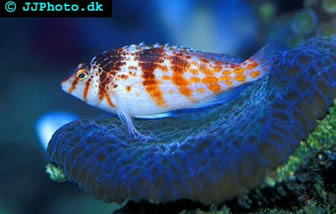Hawkfish
Hawkfish is found in the family Cirrhitidae in the order Perciformes. Fishbase currently lists 32 species divided into 12 different genera:
Amblycirrhitus
Cirrhitichthys
Cirrhitops
Cirrhitus
Cristacirrhitus
Cyprinocirrhites
Isocirrhitus
Itycirrhitus
Neocirrhites
Notocirrhitus
Oxycirrhites
Paracirrhites
The hawkfish is very similar to the members of the family Scorpaenidae (commonly known as Rockfish/Scorpionfish/Lionfish), but without the prominent head spines.
Hawkfish in the aquarium
Vibrantly coloured hawkfishes are popular among aquarists and they are also known to adapt well to aquarium conditions. Hawkfish is kept in fish-only community aquariums as well as in reef tanks. You should however keep in mind that the hawkfish will eat most animals – including fish, crustaceans and “worms” – if they are small enough to devour. The hawkfish is equipped with sharp teeth and powerful jaws and can easily crush the protective shell of a crustacean.
A hawkfish that lives in the same aquarium set up for a long time can become territorial. You can prevent this by rearranging the set up once in a while, e.g. by moving rocks.
Geograpical range, habitat and habits
Hawkfishes occur in the Indian Ocean, Pacific Ocean and the tropical western and eastern parts of the Atlantic. A majority of the species is Indo-Pacific, but two species live in the Atlantic.
All hawkfishes are marine and hawkfish cannot be found in brackish or fresh water. Most species prefer to stay in shallow water and go no deeper than 100 feet (30 meters), but some can venture down to a few hundred feet. The hawkfish is active during the day.
The hawkfish is strongly associated with coral reefs and is often found in the upper part of the reef. The fish is equipped with large, skinless pectoral fins that makes it possible for the fish to perch itself upon flame corals without being injured. Flame corals are not true corals; they are hydrozoans with dangerous nematocysts (stinging cells) capable of delivering a painful sting.
Hawkfishes are typically solitary creatures but some species form pairs and can share a coral head. There are also species that form harems consisting of one male and up to seven females. If the male is removed, a female will turn male and take his place in the harem. This is called protogynous hermaphrodism.
Feeding hawkfish
The hawkfish will typically perch itself upon rock or coral and stay as still ass possible until it gets a chance to dart out and grab a prey. Interestingly enough, the hawkfish does not have any swim bladder. It feeds on small fishes, crustaceans and other invertebrates. As mentioned above, the fish is equipped with sharp teeth and strong jaws and can easily crush shells. The teeth are short and conical and modified to be ideal for grasping small fish and zooplankton.
In the aquarium, the hawkfish can be easily trained to accept frozen and dry food. It is not a good idea to feed your hawkfish prepared foods only.
Breeding hawkfish
Most Hawkfishes are protogynous hermaphrodites that spawn near the surface in the open water. They do not guard their offspring. Spawning will take place at night with the female releasing a large amount of buoyant eggs that is promptly fertilized by the male. Since the eggs are buoyant, they will intermingle with the planktons of the ocean and be swept away by currents.
Hatching is believed to occur after roughly three weeks but more research is needed before we can now for sure.
The Longnose hawkfish (Oxycirrhites typus) is not a pelagic spawner; this species will lay demersal eggs. (Demersal = at or near the bottom.) The Longnose hawkfish (Oxycirrhites typus) is the only hawkfish that has been successfully bred in aquariums.
Hawkfish Articles:
Flame Hawkfish – Neocirrhites armatus
Longnose Hawkfish – Oxycirrhites typus
Arc-eye Hawkfish – Parachirrhites arcatus
Anthias
Aquarium Chillers
Basses
Batfish
Blennies
Butterflyfish
Cardinalfish
Clown fish
Corals
Damselfish
Files
Goatfish
Gobies
Gorgonians
Grammas
Groupers
Grunts
Hawkfish
Jawfish
Jellyfish
Lionfish
Dragonets
Mantis shrimp
Marine angelfish
Marine Catfish
Moray eels
Nudibranch
Octopus
Pipefish
Protein skimmers
Pufferfish
Rabbitfish
Rays
Snappers
Scorpionfish
Sea Anemones
Sea horses
Sea Stars
Shark Fish
Shrimps
Snails
Squirellfish
Surgeonfish
Triggerfish
Wrasses

